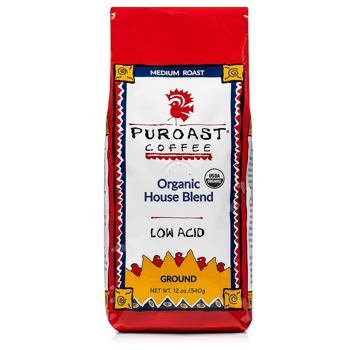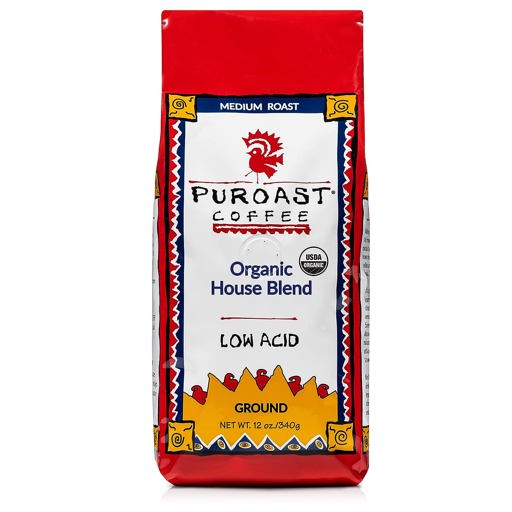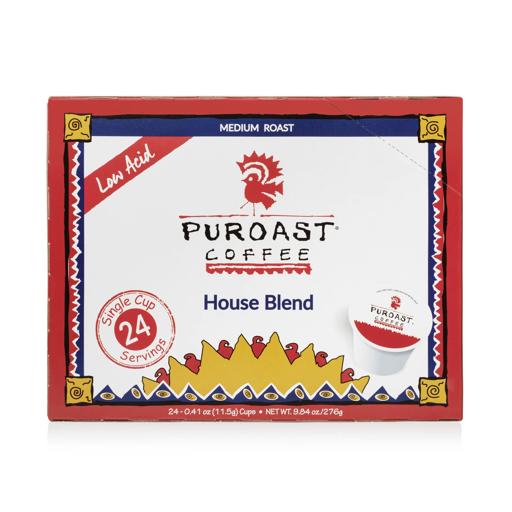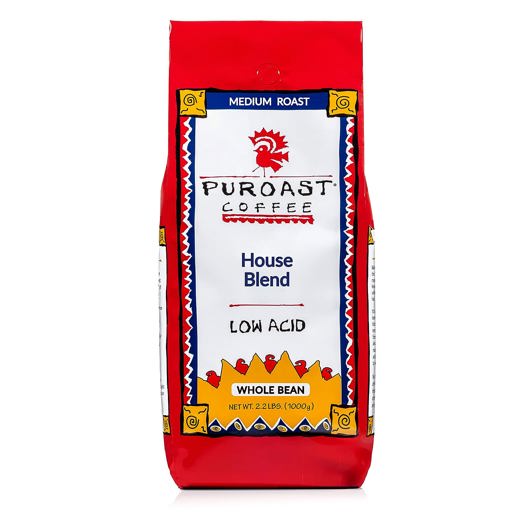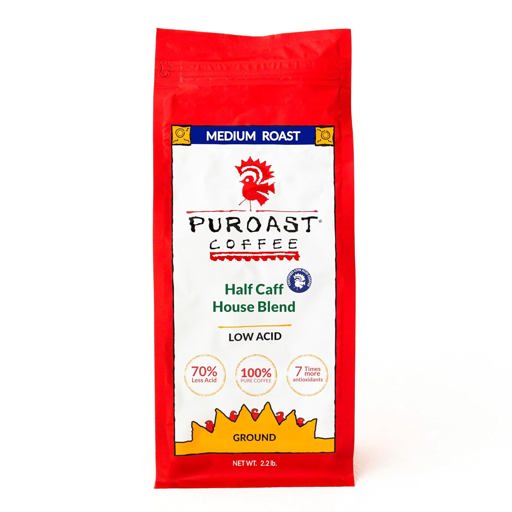Bestsellers for Health Benefits
For many, a morning cup of coffee is an essential start to the day. However, for some individuals, this beloved ritual can lead to discomfort and stomach aches. The culprit could be anything from caffeine sensitivity to high acidity typically found in conventional coffees. Understanding your body's reactions and exploring alternatives like decaffeinated brews or low-acid options might provide relief without having to give up on coffee altogether. Sometimes, even small changes in our daily coffee routine can make all the difference.
Symptoms of Coffee Intolerance
 These symptoms can vary widely but often include gastrointestinal discomfort such as stomach pain, which might be a sign of sensitivity to the acidity or caffeine in coffee. Other common signs of coffee intolerance are:
These symptoms can vary widely but often include gastrointestinal discomfort such as stomach pain, which might be a sign of sensitivity to the acidity or caffeine in coffee. Other common signs of coffee intolerance are:
Nausea: Feeling queasy or sick to your stomach after drinking coffee.
Heartburn: A burning sensation in the chest, often after eating or at night, which is exacerbated by coffee consumption.
Bloating: An uncomfortable feeling of fullness in the belly area.
Diarrhea: Loose, watery stools that may occur shortly after consuming coffee.
Jitters or restlessness: Those who have a sensitivity to caffeine may feel overly anxious or shaky after drinking coffee.
Headaches: For certain people, headaches can emerge as a result of caffeine consumption due to their sensitivity to its effects.
For those who love their daily brew but find themselves struggling with these issues, seeking out low-acid options could provide relief while offering a way for people with sensitivities or intolerances to enjoy their favorite beverage without discomfort.
Understanding Caffeine Sensitivity
 This sensitivity can lead to symptoms that mimic or contribute to stomach aches after consuming coffee. The body's response to caffeine is influenced by several factors including genetics, the amount of coffee consumed, and individual tolerance levels.
This sensitivity can lead to symptoms that mimic or contribute to stomach aches after consuming coffee. The body's response to caffeine is influenced by several factors including genetics, the amount of coffee consumed, and individual tolerance levels.
People with higher caffeine sensitivity may experience:
Increased heart rate: A rapid heartbeat can occur even with small amounts of caffeine.
Insomnia: Difficulty falling asleep or staying asleep due to the stimulant effect of caffeine.
Nervousness: Feelings of anxiety or unease after drinking caffeinated beverages.
Upset stomach: Caffeine stimulates acid production in the stomach which can cause discomfort.
Those who metabolize caffeine slowly are particularly prone to these effects because the substance remains in their system longer. Reducing intake often helps manage symptoms but does not address underlying sensitivities.
For those sensitive to both acidity and caffeine, low-acid coffees that also have reduced levels of this stimulant could be beneficial. These products aim to minimize gastrointestinal irritation while still providing a satisfying coffee experience. They cater specifically to people looking for a gentler alternative without sacrificing flavor.
Understanding Coffee Acidity
 Acidity refers to the concentration of hydrogen ions, and it's measured on the pH scale where lower numbers indicate higher acidity. Coffee typically has a pH between 4.8 and 5.2, which can stimulate acid production in the stomach.
Acidity refers to the concentration of hydrogen ions, and it's measured on the pH scale where lower numbers indicate higher acidity. Coffee typically has a pH between 4.8 and 5.2, which can stimulate acid production in the stomach.
The roasting process of coffee beans significantly influences their final acidity level. Darker roasts tend to be less acidic because prolonged exposure to heat breaks down more of the acidic compounds.
Different preparation methods also affect coffee’s acidity. For example, cold brew often results in a less acidic beverage due to its longer steeping time at lower temperatures.
Individuals with sensitive stomachs may find that certain types of coffee exacerbate symptoms like heartburn or indigestion due to their high acidity levels.
Research indicates that both caffeinated and decaffeinated coffees decrease pressure on the lower esophageal sphincter (LES), potentially leading to acid reflux regardless of caffeine content, so if you've cut back on caffeine but are still experiencing symptoms, reducing the acidity levels in your coffee may help.
Studies have shown that specific components in roasted coffee can regulate proteins related to gastric acid secretion, suggesting that certain elements within coffee influence its impact on digestion beyond just caffeine.
For those who experience discomfort from traditional coffees but do not want to give up their daily cup, low-acid options provide an alternative for sensitive digestive systems while maintaining flavor quality.
Do I Have to Quit Drinking Coffee?
 There are ways to continue enjoying your daily cup without the discomfort. Here's what you can consider:
There are ways to continue enjoying your daily cup without the discomfort. Here's what you can consider:
Monitor your intake: Keep an eye on how much coffee you consume and consider cutting back if necessary.
Try low-acid coffee: This type of coffee is designed for those with sensitive stomachs and can prevent irritation.
Experiment with brewing methods: Brewing techniques like cold brew tend to result in a less acidic cup of joe.
Avoid additives: Creamers and sugars may contribute to the acidity; try enjoying your brew without them.
Choose dark roasts: Darker roasted beans generally have lower acid levels than their lighter counterparts.
Remember that individual tolerance varies greatly, so finding what works best for you might take some trial and error.
Research supports the idea that certain types of coffee are easier on the digestive system while still providing health benefits such as increased antioxidants.
For those who experience symptoms like heartburn or indigestion from regular coffees but don't want to give up their beloved beverage, low-acid options offer a solution by reducing potential irritation.
Alternative Brewing Methods to Make Coffee Less Irritating
 These methods may alter the chemical composition of coffee, potentially reducing any irritating properties.
These methods may alter the chemical composition of coffee, potentially reducing any irritating properties.
Cold Brew Method: Results in a less acidic beverage as grounds steep in cold water for 12 to 24 hours, extracting fewer acidic compounds and offering a smoother cup. For our guide to brewing cold brew coffee, visit here.
Steam-Treated Coffee: Reduces acidity by steaming beans before brewing, which can lead to less gastric acid secretion without significantly affecting caffeine content.
French Press or Pour-Over Brewing: Allows more control over brewing time and temperature, potentially reducing the coffee's acidity levels.
Use of Paper Filters: Traps oils and compounds that may increase stomach acid production, providing a milder option for those with sensitivities. This method also reduces the amount of cholesterol in brewed coffee.
Grind Size Adjustment: A coarser grind might result in lower acid extraction during the brewing process due to slower extraction rates.
Filtered Water Usage: Utilizing filtered water instead of tap can remove minerals that contribute to higher acidity levels in coffee.
Brewing Time Management: Shorter brew times often mean less acid is extracted from the beans, which could be gentler on the stomach.
Use Low-Acid Coffee Beans: Low-acid beans can be prepared using any method, including cold brew. To learn more about brewing low-acid coffee, visit here.
Low-Acid Coffee Alternatives
 Low-acid coffee is less likely to trigger symptoms like heartburn or indigestion. Here are some benefits and features of low-acid coffees:
Low-acid coffee is less likely to trigger symptoms like heartburn or indigestion. Here are some benefits and features of low-acid coffees:
Reduced irritation: Low-acid coffees cause less irritation to the stomach lining, which is beneficial for individuals with acid reflux or sensitive digestive systems.
Enhanced comfort: By minimizing acid content, these coffees offer a more comfortable drinking experience for those prone to gastrointestinal distress.
Flavor retention: Despite lower acidity, these alternatives still deliver rich and full flavors, satisfying even discerning palates.
Research has shown that certain roasting processes can decrease coffee's natural acidity. Darker roasts typically have less acid due to longer roasting times breaking down more acidic compounds. Additionally, specific treatments such as steam-treating beans before brewing can further reduce irritant components.
For consumers seeking low-acid options without sacrificing taste or resorting to extensive home-brewing modifications, Puroast provides an ideal solution with its patented roasting process inspired by traditional Andean techniques – ensuring you get your beloved cup without unwanted side effects.
FAQ
What causes some coffee to be more acidic than others?
Acidity in coffee is largely influenced by the altitude at which the coffee is grown, the type of coffee bean, the roasting process, and the brewing method. Beans from higher altitudes and Arabica beans tend to have greater acidity. Lighter roasts preserve more of the bean's original acidity, and brewing methods that involve lengthy contact with water, like cold brew, can extract fewer acidic compounds resulting in a less acidic coffee.
Can decaf coffee still cause an upset stomach?
Many coffee lovers turn to decaf in hopes of enjoying their favorite beverage without the stomach upset that can sometimes accompany caffeinated varieties. However, it's important to understand that decaffeination doesn't necessarily mean a completely acid-free experience. Decaf coffee can still contain compounds that stimulate gastric acid production, which may lead to discomfort for some individuals.
The good news is that not all decaf coffees are created equal when it comes to acidity and its potential impact on the stomach. The Swiss Water Process, a chemical-free method used by Puroast, significantly reduces the likelihood of an upset stomach compared with other methods of decaffeination. This process relies solely on water, temperature, and time to remove caffeine while maintaining the beans' original flavor profile.
During this gentle process, green coffee beans are soaked in hot water to dissolve the caffeine. The water is then passed through a charcoal filter which captures caffeine molecules but leaves behind most of the beans' natural oils and flavor compounds. As a result, Swiss Water Processed decaf is easier on your digestive system because it minimizes harsh irritants without using chemicals.
Puroast takes pride in offering low-acid coffee options—including our Swiss Water Processed decaf—that provide all the taste without as much risk for an upset stomach. By choosing such products, individuals who are sensitive to acidic beverages are more likely to continue enjoying their delicious cup of coffee each day.
In summary, while traditional decaf coffees might still pose issues for those prone to gastrointestinal distress due to residual acids and other compounds affecting acid production and esophageal function; opting for Swiss Water Processed alternatives like those from Puroast could offer a more comfortable experience.
Are there specific coffee roasts that are better for a sensitive stomach?
Darker roasts are generally considered better options for individuals with sensitive stomachs as they tend to have lower levels of acidity. The prolonged roasting time breaks down more of the acidic compounds present in the coffee beans.
Can I make my coffee less acidic at home?
Home brewing adjustments can make your coffee less acidic. Utilize a coarser grind, opt for a dark roast, and consider brewing methods like cold brew or using paper filters, which can reduce the coffee's overall acidity. Additionally, brewing coffee for a shorter period can limit acid extraction.
How does cold brew coffee compare to hot coffee in terms of acidity?
Cold brew coffee is typically lower in acidity than hot coffee. The cold brewing process extracts fewer acidic compounds from the beans, as it uses cold water over an extended period, unlike the quick extraction process of hot water which releases more acidity from the beans.
Does adding milk or cream to coffee reduce its acidity?
Adding milk or cream alters the overall pH balance of coffee, but only to a minimal extent. While milk can create a buffer and may slightly neutralize some acidity, the coffee's inherent acidity can still cause discomfort if you have a sensitive stomach.
Is it possible to determine the acidity level of coffee before purchasing it?
While acidity levels are not typically listed on coffee packaging, some brands specifically market their coffee as low-acid. Looking for terms like "low-acid" or "gentle on the stomach" can guide you to coffees with less acidity. Reading the product descriptions and customer reviews can also provide insights into a coffee's acidity.
For those who are particularly sensitive to acid in their diet, Puroast Coffee has the lowest acidity in America—averaging 5.7 pH. This is significantly lower than many conventional coffees that often have pH levels closer to 5—a difference that may seem small but is quite substantial when it comes to how our bodies perceive acidity.
The benefit of this lower acidity is twofold: it provides a smoother cup of coffee that many people find more enjoyable and easier on the digestive system—making it an excellent choice for those with acid reflux or other gastrointestinal sensitivities.
Understanding pH levels can be helpful; they measure how acidic or basic (alkaline) a substance is on a scale from 0 to 14, with lower numbers being more acidic and higher numbers being more alkaline. Water, for example, has a neutral pH of around 7.
While most coffees do not advertise their specific acidity levels directly on the package, by choosing Puroast you're selecting a brand known for its naturally low-acid profile due to our proprietary roasting technology—a thoughtful choice for anyone seeking both exceptional taste and reduced dietary acid intake.
Will switching to low-acid coffee change the taste?
Low-acid coffee is designed to deliver a smooth taste while reducing acidity levels. While taste is subjective, most low-acid coffees are made to preserve the rich flavors of traditional coffee without the harshness that can come with high acidity.
What role does the pH scale play in identifying low-acid coffee?
The pH scale measures how acidic or basic a substance is on a scale from 0 to 14, with lower numbers indicating higher acidity. Most regular coffees fall between a pH of 4.8 to 5.2. Low-acid coffees would have a higher pH number, indicating lower acidity levels. Puroast Coffee has the lowest acidity in America—averaging 5.7 pH.
Does the water used in coffee brewing affect acidity?
Water quality can influence the acidity of brewed coffee. Using filtered water might remove certain minerals that could contribute to a higher acidity level in the coffee. Tap water's mineral content varies by location and could impact the acidity of the final brew.
What is the typical shelf life of low-acid coffee?
Low-acid coffee, like regular coffee, should maintain its freshness and flavor for about two to three weeks after opening when stored properly. For optimal freshness, keep the coffee in a cool, dark place, away from direct sunlight, and in an airtight container.
Are organic coffees less acidic?
Organic certification does not directly relate to the level of acidity in coffee. Organic coffees can vary in acidity just like non-organic coffees. Focus on the roasting process, bean type, and brewing method for indicators of lower acidity, rather than the organic label.
Can low-acid coffee help with acid reflux?
Low-acid coffee is specifically designed to have less of an impact on the stomach, potentially mitigating symptoms like acid reflux. It contains fewer irritants that can weaken the lower esophageal sphincter, reducing the likelihood of acid reflux episodes.
How does the roasting process reduce acid in coffee?
During the roasting process, high temperatures break down some of the chlorogenic acids in the coffee beans, which are part of what makes coffee acidic. Lengthier roasting times, like those used for dark roasts, can result in less acidic coffee as more of these acids are broken down.
Are there any benefits to drinking low-acid coffee besides reduced stomach irritation?
Apart from being easier on the stomach, low-acid coffee may lead to less enamel erosion on teeth and could be preferable for individuals with chronic conditions like GERD or ulcers. Plus, the smoother flavor can be a benefit for those who find regular coffee too bitter or harsh.
Puroast does not provide medical advice, diagnosis, or treatment. Any information published on this website or by this company is not intended as medical advice. Always consult a qualified health or mental health professional with any questions or concerns about your physical or mental health.
Puroast Buying Guide

When it comes to choosing a coffee that is gentle on your digestion, there are a few key factors to consider. First and foremost, look for a coffee that boasts low acidity. This will help reduce the risk of heartburn, acid reflux, and other gastrointestinal issues. Puroast Low Acid Coffee House Blend is an excellent option in this regard, with its 70% less acid compared to regular coffee.
Another important aspect to consider is the antioxidant content of the coffee. Antioxidants play a crucial role in promoting overall health and well-being. Puroast coffee stands out in this area, with its 7x higher antioxidant levels than green tea and 5x higher than leading coffee brands. These antioxidants can help combat free radicals in the body and provide numerous health benefits.
In addition to low acidity and high antioxidants, it's also essential to choose a coffee that is sustainably sourced and free from chemicals and pesticides. Puroast takes pride in its commitment to quality and sustainability, sourcing their high elevation grown coffee beans from sustainable farms and ensuring they are kosher and chemical/pesticide-free.
Lastly, consider the taste and aroma of the coffee. While the primary focus may be on its health benefits, it's equally important to enjoy the flavor of your coffee. Puroast's unique roasting method creates a smooth and aromatic cup of coffee that won't leave a bitter aftertaste, making it a delightful choice for coffee enthusiasts.
In conclusion, when shopping for a coffee that is good for your digestion, prioritize low acidity, high antioxidants, sustainable sourcing, and great taste. Puroast Low Acid Coffee House Blend checks all these boxes, making it an excellent choice for those seeking relief from coffee-related digestive issues while still enjoying a flavorful cup of joe. Here are some products we recommend.
Puroast Low Acid Coffee Organic House Blend
Puroast Low Acid Coffee is a delicious brew with 70% less acid than regular coffee, 7X the antioxidants of green tea and no bitter aftertaste. It's sustainably sourced, chemical/pesticide free, and made using renewable, clean technology. Enjoy the smooth and aromatic cup of coffee without any digestive issues!
- Low acid content makes Puroast Coffee perfect for those with sensitive stomachs or acid reflux issues.
- The coffee boasts a higher antioxidant level, offering potential health benefits.
- Certified as organic, ensuring a natural and chemical-free product.
- The medium roast brings out a balanced flavor, not too bitter or too light.
- Puroast Coffee is great for making a variety of drinks like espresso and iced coffee.
- With a pH of 5.5+, this coffee promotes gut health.
- Customers love the smooth taste of this house blend.
Puroast Low Acid Coffee House Blend Single-Serve Pods
Puroast Low Acid House Blend Single Cup Coffee is a fantastic choice for those looking for symptom relief from heartburn, acid reflux, and other stomach problems. It is produced using a proprietary roasting technology that reduces acidity by 70%, provides delicious flavor, and contains 7 times more antioxidants than green tea. With 96 cups included in the package, it is an excellent value for the price.
- Coffee has an excellent taste
- Better on the stomach due to low acidity
- Ideal for people with sensitive stomachs
- Offers the best of both worlds - taste and low acidity
- Can be enjoyed as a second cup of coffee at work
- Despite being pricey, it's considered worth the cost
- It's the only acceptable coffee for some due to its low acidity
Puroast Low Acid Coffee House Blend
Size Guide
Amazon - 2.2LB
Puroast Direct - 2.5LB
Description
Puroast Low Acid Whole Bean Coffee is perfect for those with heartburn or acid reflux, as it has 70% less acid than other coffees. It also contains 7x higher antioxidants than green tea and 5x higher antioxidants than leading coffee brands. Their unique roasting method creates a low-acid blend that won't upset your stomach, and they use renewable clean technology for their roasters. Additionally, the coffee is sustainably sourced, kosher, and chemical/pesticide free.
- Customers love the low acid content of Puroast Coffee, making it a great choice for those with sensitive stomachs or acid reflux.
- Many reviews mention the high antioxidant level as a significant health benefit.
- The Premium House Blend is highly praised for its rich and smooth flavor.
- Users appreciate that it's a caffeinated coffee, providing them with the needed energy boost in the morning.
- The large 2.2-pound, or 1000 gram bag, offers excellent value for money, according to many reviews.
- It is a whole bean coffee, allowing for fresh grinding and optimal flavor retention.
- Many customers are repeat buyers, indicating high satisfaction with the overall quality and taste of this product.

